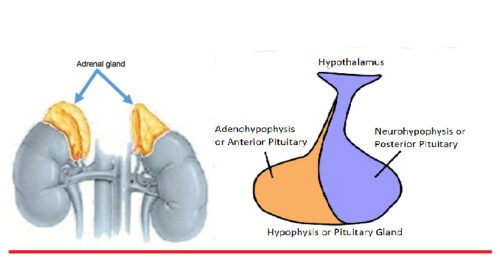The endocrine system consists of a number of ductless glands which produces chemical substances, known as a hormone. Hormones work individually in very low concentration and take part in different chemical reactions or can act as a catalyst. They are generally protein in nature and never stored in any other place for future use except the secretary glands or tissues.
ADH (Anti-diuretic Hormone) is also known as Vasopressin, arginine vasopressin (AVP) or argipressin. It is a neuro-secretary peptide hormone comes from the hypothalamus and it is released by the posterior pituitary gland. It is responsible for many metabolic processes of the body. Just beneath the hypothalamus, ADH is secreted into the blood. It is protein in nature and contains nine amino acids such as tyrosine, phenylalanine, glutamine, asparagine, proline, arginine, glycine, cysteine, etc. It is stored in granules accumulated at the axon terminals situated in the posterior pituitary. This hormone is transmitted from the axon terminal of the neuron to the capillary beds in the pars nervosa of the posterior pituitary.

Chemical Structure of ADH with Labeled Amino Acids
Aldosterone is a mineralocorticoid steroidal hormone like cortisol which is made of cholesterol and secreted from the adrenal cortex of the adrenal gland.

Chemical Structure of Aldosterone
In the body, the two hormones (ADH and Aldosterone) are released under low blood pressure conditions. They also act on the distal convoluted tubules and collecting tubules of the nephron. ADH makes the distal convoluted tubules (DCT) more porous to water while aldosterone makes the distal convoluted tubules (DCT) more penetrable to mineral particles, for example, sodium ions which increase the water re-absorption by making an osmotic pressure.
Functions of ADH
- Antidiuretic hormone (ADH) plays an important role to maintain osmoregulation of the body by controlling the amount of urine formation.
- ADH preserves water directly through its re-absorption capacity.
- With the small dose, ADH increases re-absorption of water from the renal tubules thus decreases the volume of excretory urine (antidiuresis).
- It causes diabetes insipidus due to a lack of ADH. It is a condition in which a large volume of water is consumed and then lost by frequent excretion of dilute urine (dieresis).
- It raises the blood pressure by causing arteriolar and capillary constriction with a large dose of ADH.
- It stimulates and contracts all the voluntary muscles in the body.
- It also stimulates plain muscles of urinary bladder, ureter, intestine, uterus, etc.
- ADH acts as chemical messengers and moves to the kidney via the blood.

Role of Antidiuretic hormone (ADH)
Functions of Aldosterone
- Aldosterone preserves water indirectly through the re-absorption of sodium ions(Na+).
- Aldosterone helps to stimulate sodium (Na+) absorption from the gut and decrease the loss of Na+ ions from sweat and salivary glands.
- It promotes the secretion of K+ in the tubular lumen.
- It stimulates the secretion of hydrogen ions (H+) via the H+/ATPase in the intercalated cells of the cortical collecting tubules.
- Aldosterone acts as mineralocorticoid receptors and positively influences the neurogenesis system in the dentate gyrus (part of a brain region).
- It influences the fats, carbohydrates, and proteins metabolism.

Aldosterone Feedback Loop
Difference between ADH and Aldosterone
Some important differences between ADH and Aldosterone are stated in the following table:
| ADH | Aldosterone |
|---|---|
|
ADH (anti-diuretic hormone) is a peptide hormone. |
Aldosterone is a corticosteroid hormone. |
|
It is secreted by the posterior pituitary gland. |
It is synthesized and secreted by the adrenal cortex. |
|
It prevents the production of dilute urine. |
It stimulates the absorption of sodium by the nephron to maintain water and salt balance. |
|
It is secreted when the body is dehydrated. |
It is secreted when blood pressure is low. |
|
It increases blood pressure through vasoconstriction. | It has no effect on the blood vessels. |
|
It makes the distal convoluted tubule (DCT) and collecting tubules (CT) more permeable to water. |
It makes the distal convoluted tubule (DCT) and collecting tubules (CT) more permeable to sodium ions. |
|
It stimulates the kidney to reabsorb more water. |
It increases the NaCl and water absorption capacity of the kidney by making an osmotic pressure. |
|
It is discharged in response to hypertonicity of the blood and in response to cholecystokinin. |
It is discharged in response to the increased plasma angiotensin III, ACTH, serum potassium concentrations, etc. |
|
ADH is inhibited by Diuretics such as alcohol (CH3-CH2-OH). |
It is inhibited by ACE (Angiotensin-converting enzyme), dopamine, and atrial natriuretic hormone (ANH). |
Some Similarities between ADH and Aldosterone
- Both ADH and aldosterone hormones increase the water re-absorption from the nephron.
- They work on collecting tubules (CT) and the distal convoluted tubules (DCT) of the nephron.
- They are secreted under low blood pressure.
- They increase blood pressure while producing concentrated urine.
Also read: Vitamins : Classification, Functions and Deficiency Symptoms

